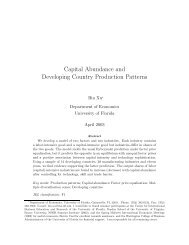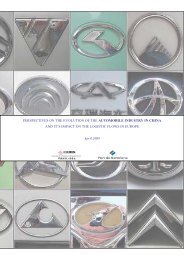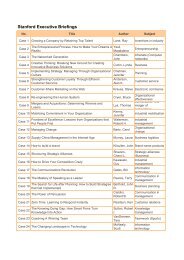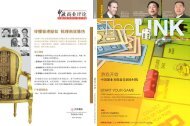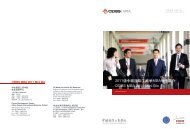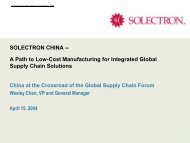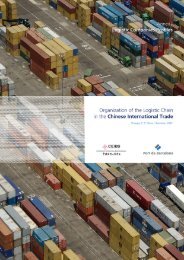Untitled - China Europe International Business School
Untitled - China Europe International Business School
Untitled - China Europe International Business School
You also want an ePaper? Increase the reach of your titles
YUMPU automatically turns print PDFs into web optimized ePapers that Google loves.
Organization of the logistic chain in the Chinese international trade<br />
Companies exporting to <strong>Europe</strong> put big emphasis in the importance of the transit times between the<br />
port in <strong>China</strong> and the port in <strong>Europe</strong>, and if the carrier has direct or non-direct call to the destination<br />
port.<br />
Shipping routes (schedules, ports of call and frequency) are established by shipping lines according to<br />
the flows of cargo. Several key elements determine the order to call ports: cargo volumes, feeder<br />
frequency and transshipment cost, berthing windows, cost of handling containers, logistics and<br />
transportation network of the port’s hinterland, terminal’s level of service among others.<br />
Logistics facilities<br />
Companies’ main requirement in <strong>China</strong> is a consolidation center. The consolidation centers are usually<br />
managed by <strong>International</strong> forwarders. The location and type of facility depends mainly on the price<br />
requirements and on the level of sophistication of the product and services required. Facilities in<br />
Logistic parks, trade zones and bonded areas are more expensive and sometimes still in an initial<br />
phase of operating so policies are not clear enough and operations can suffer from it.<br />
The distribution within <strong>Europe</strong> is usually decided and organized in <strong>Europe</strong> by the company or through a<br />
3PL, with the support of distribution centers or through shipments of FCL directly to customers’<br />
facilities.<br />
The Logistic department in <strong>China</strong> does not participate in the decision-making and has a superficial<br />
knowledge of the <strong>Europe</strong>an part of the logistic chain.<br />
Companies usually make the difference on the kind of infrastructure they need depending on:<br />
� When the goods are in a transit country, companies require facilities in bonded areas.<br />
� When the goods need processing (assembly, packaging, etc) or for further distribution,<br />
companies require facilities in logistic parks with good land connections.<br />
On the other hand, when Chinese exporters are starting in a new market within <strong>Europe</strong>, before<br />
organizing their own distribution center, they demand warehousing space to freight forwarders to<br />
storage some goods to ensure a good service to new customers, reliability and to shorten delivery<br />
times, etc…Later, if the business is working, they will create their own distribution center.<br />
CEIBS Port of Barcelona Chair of Logistics 53



